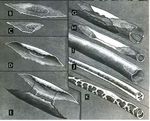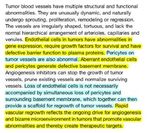What is angiogenesis? 09/05/2013
←
→
Page content transcription
If your browser does not render page correctly, please read the page content below
09/05/2013
Angiogenesi tumorale
What is
angiogenesis?
Angiogenesis: recruitment of endothelial cells
from existing vessels
Vasculogenesis: activation of endothelial cell
precursors
109/05/2013
Int. Symp. "Angiogenesis. Key principles, Science, Technology, Medicine“
St. Gallen, Svizzera, 1991 Tumor Angiogenesis and Neovasculature
Prof. Pietro Gullino Dr. Steve Brem
Prof. Judah Folkman
A, Tumors less than 1 mm3 receive oxygen and nutrients by diffusion from host
Prof. Rakesh Jain vasculature. B, Larger tumors require new vessel network. Tumor secretes angiogenic
factors that stimulate migration, proliferation, and neovessel formation by endothelial
cells in adjacent established vessels. C, Newly vascularized tumor no longer relies
solely on diffusion from host vasculature, facilitating progressive growth.
Abnormal Structural Features of Struttura dei vasi sanguigni normali
Tumor Microvasculature
AV = arteriovenous.
From Brown and Giaccia. Cancer Res. 1998;58:1408-1416, with permission.
Struttura vasi normali, segue Periciti
Cellule correlate alle cellule muscolari lisce vascolari.
pericita Queste cellule sono adiacenti e circondano l’endotelio, condividono
una lamina basale comune e hanno giunzioni di tipo “gap” con le
cellule endoteliali,
Non è ancora chiaro se queste cellule siano multipotenti, con la
capacità di differenziarsi sia in cellule muscolari lisce o persino
cellule endoteliali.
(Bergers G, Benjamin LE. Tumorigenesis and the angiogenic switch. Nat Rev Cancer. :401-410, 2003).
http://www.udel.edu/biology/Wags/histopage/vascularmodelingpage/circsystempage/capillaries/capillaries.html
209/05/2013
http://www.medscape.org/viewarticle/461038_7 http://www.medscape.org/viewarticle/461038_7
Bergers & Benjamin. Nat Rev Cancer. 2003 Jun;3(6):401-10.
The angiogenic balance (1)
Angiogenesis is orchestrated by a variety of activators and
inhibitors — only a few of which are listed in the picture above.
Activators of endothelial-cell proliferation and migration are
mainly receptor tyrosine kinase ligands, such as vascular
endothelial growth factor (VEGF), fibroblast growth factors
(FGFs), platelet-derived growth factor (PDGF) and epidermal
growth factor (EGF), but can also be of very different origin,
such as lysophosphatic acid (LPA).
EGF upregulates VEGF, FGF and interleukin-8, whereas LPA
upregulates VEGF levels.
The first described angiogenic inhibitor was
thrombospondin-1, which modulates endothelial-cell
proliferation and motility.
Bergers & Benjamin. Nat Rev Cancer. 2003 Jun;3(6):401-10. Bergers & Benjamin. Nat Rev Cancer. 2003 Jun;3(6):401-10.
309/05/2013
The angiogenic balance (2)
Remarkably, many inhibitory molecules, such as ‘statins’, are
derived from larger proteins that have no effect on
angiogenesis.
Among those that are listed are angiostatin (a fragment of
plasminogen that binds ATP synthase and annexin II), as well
as endostatin, tumstatin and canstatin (fragments of
collagens that bind to integrins).
In general, the levels of activators and inhibitors dictate
whether an endothelial cell will be in a quiescent or an
angiogenic state.
It is believed that changes in the angiogenic balance
mediate the angiogenic switch.
Bergers & Benjamin. Nat Rev Cancer. 2003 Jun;3(6):401-10. Bergers & Benjamin. Nat Rev Cancer. 2003 Jun;3(6):401-10.
The classical angiogenic switch [interrutore].
The angiogenic switch is a discrete step in tumour development that
can occur at different stages in the tumour‐progression pathway,
depending on the nature of the tumour and its microenvironment.
Most tumours start growing as avascular nodules (dormant) (a) until
they reach a steady‐state level of proliferating and apoptosing cells.
The initiation of angiogenesis, or the ‘angiogenic switch’, has to occur
to ensure exponential tumour growth.
The switch begins with perivascular detachment and vessel dilation
(b), followed by angiogenic sprouting (c), new vessel formation and
maturation, and the recruitment of perivascular cells (d).
Blood‐vessel formation will continue as long as the tumour grows, and
the blood vessels specifically feed hypoxic and necrotic areas of the
tumour to provide it with essential nutrients and oxygen (e).
Bergers & Benjamin. Nat Rev Cancer. 2003 Jun;3(6):401-10. Bergers & Benjamin. Nat Rev Cancer. 2003 Jun;3(6):401-10.
Normal vasculature (on right) is very
orderly, unbranched, nearly parallel
vessels compared with tumor vasculature
(on left)
409/05/2013
Typical structure of tumor vasculature
Note coiling,
irregularity,
size
heterogeneity
New blood-vessel formation. Blood vessels arise from pre-existing capillaries or post-
capillary venules in tumours (a). b | First, pericytes (green) detach and blood vessels dilate
before the basement membrane and extracellular matrix is degraded. c | This allows
endothelial cells (red) to migrate into the perivascular space towards angiogenic stimuli
produced by the tumour cells or host cells. d | Endothelial cells proliferate, loosely following
each other, and are presumably guided by pericytes. e | Behind the migration columns,
endothelial cells adhere to each other and create a lumen, which is accompanied by
basement-membrane formation and pericyte attachment. Finally, blood-vessel sprouts will
fuse with other sprouts to build new circulatory systems. Little is known about this fusion
mechanism.
Small tumors are not always avascular masses stimulating
vessel growth…some “co-opt” existing vessels, then
stimulate angiogenesis through hypoxia
Blood vessel co-option precedes angiogenesis in astrocytoma progression.
Astrocytomas first acquire their blood supply by co-opting existing normal brain blood vessels
without the necessity to initiate angiogenesis. They instead grow along blood vessels, without
a tumour capsule, eliciting an invasive character (a) . When grade III astrocytomas progress
into glioblastomas (GBM or grade IV astrocytoma), they become hypoxic and necrotic —
partly due to vessel regression and increased tumour-cell proliferation (b). These conditions,
in turn, induce formation of new blood vessels (angiogenic sprouting) (c) that supply the
tumour with the necessary metabolites. In fact, glioblastomas are partly defined by the
appearance of proliferating endothelial cells and a high blood-vessel density that distinguishes
grade IV tumours from the lower-grade astrocytomas
Endothelial cells are aligned into three zones during
angiogenesis.
Basement Parent ZONE III ZONE II ZONE I
membrane
vessel
VEGF and FGF-2
Direction of growth
Migrating cells – – + Cathepsins,
Dividing cells – + – MMPs
Maturing cells + –
–
509/05/2013
I VASI SANGUIGNI ANORMALI (sopra) complicano il caos all’interno del tumore ed
impediscono ai trattamenti di raggiungere le cellula tumorali. La possibilità di
“normalizzare” tali vasi (sotto) li rende una sorta di arma funzionale che può essere
utilizzata contro il tumore.
609/05/2013
(b) Untreated tumor showing a disorganized, anastomotic network
(a) Normal vasculature showing hierarchy of arterioles, capillaries and of vessels that lacks the conventional hierarchy. Arterioles,
venules, which all have a characteristic size, shape and wall structure. capillaries and venules are not discernable per se. Gaps are
Arterioles are enveloped by smooth muscle cells, and capillaries present between endothelial cells. Pericytes are irregularly
and venules are accompanied by pericytes. Thin basement shaped and loosely associated with endothelial cells. Basement
membrane surrounds all mural cells and endothelial cells. membrane has multiple layers in some places.
Baluk et al., 2005 Baluk et al., 2005
Scanning electron micrograph
showing
(a) the external (abluminal)
surface of an endothelial
sprout in a pancreatic islet
tumor from a RIP-Tag2
transgenic mouse. Multiple
filopodia (short arrows) extend
from the endothelial cell surface
near the tip of the sprout. A gap
is visible at an open endothelial
cell junction (long arrow).
Intravascular erythrocytes are
visible through the thin, nearly
transparent endothelium.
Scanning electron micrographs
(c) Vasculature of tumor after treatment with inhibitor of VEGF comparing
signaling. Many vessels have regressed, leaving empty sleeves of b) the smooth, tight endothelial cell
basement membrane (blue). Surviving vessels have a more normal monolayer covering the luminal
cylindrical shape. Loss of endothelial cells is not accompanied by surface of normal blood vessel
with
corresponding loss of pericytes. Some free pericytes are surrounded
c) the disorganized endothelium of
by basement membrane but not accompanied by endothelial cells.
vessel in a RIP-Tag2 tumor.
Blood was removed by vascular
perfusion of fixative.
Baluk et al., 2005 Baluk et al., 2005
709/05/2013
(d,e) Scanning electron micrographs showing pericytes on the surface of
irregularly shaped tumor vessels in RIP-Tag2 mice. As a reflection of their
loose association with tumor vessels, pericyte cell bodies are not located on the
Baluk et al., 2005 vessel wall, but some pericyte processes (arrows) contact endothelial cells.
I VASI SANGUIGNI in un letto vascolare del muscolo di topo
(sinistra) e all’interno di un tumore (destra) si differenziano
distintamente.
I vasi tumorali si ramificano in modo erratico, variano in diametro
lungo la loro lunghezza e sono di solito sovradimensionati – tutte
caratteristiche che contribuiscono ad un flusso ematico irregolare.
Changes produced in tumor blood vessels by inhibition of VEGF signaling. (a)
Scanning electron micrograph showing blood vessel in a RIP-Tag2 tumor treated
with inhibitor of VEGF-signaling for 7 days. The normalized vessel has a
cylindrical shape and is tightly enveloped by multiple pericyte processes Jain R.K., Scientific American, Jan 2008
(arrows).
8You can also read



























































